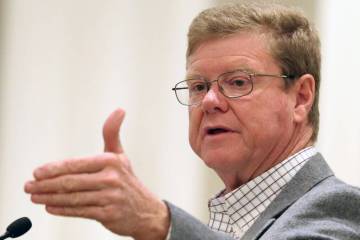Devices would let drivers skirt ban on cell use
CARSON CITY -- Cellphone and texting addicts have no reason to fret about Oct. 1 when Nevada is expected to implement a law prohibiting all drivers from texting and using hand-held cellphones.
American ingenuity already has developed the technology that will allow drivers to continue to make hands-free calls and even text with little or no inconvenience.
Most of these devices can be purchased for less than $100, even one that turns text into voice and then reads the messages to you.
The need for Nevada drivers to begin looking at new cellphone technology became apparent Tuesday when the state Senate on a 12-9 vote advanced Senate Bill 140 to the Assembly.
Under this bill, motorists of all ages could no longer text or use hand-held cellphones while behind the wheel. The bill by state Sen. Shirley Breeden, D-Henderson, also calls for a $50 fine for the first violation, $100 for the second and $250 for third and subsequent violations.
Police would give warnings until Jan. 1 when they would cite drivers.
The bill moves to the Assembly, where a similar bill with the same fines already has passed the Transportation Committee and has been referred to the Ways and Means Committee.
Sponsor Assemblyman Kelvin Atkinson, D-North Las Vegas, said he is certain his or Breeden's bill will pass.
"Leadership has signed onto the bill," Atkinson said. "We are going to have a cellphone law."
But before that happens, Republican Gov. Brian Sandoval, the father of a 14-year-old girl and a 15-year-old boy, must decide whether to sign or veto the bill.
Nine of the 10 state Senate Republicans voted no.
State Sen. Ben Kieckhefer, R-Reno, and others said they favor outlawing texting while driving, but questioned whether cellphone use by drivers should be prohibited.
As it stands now, 30 states ban all drivers from texting. Eight others prohibit juvenile drivers from texting.
Only eight states have laws like the one Nevada would implement that bans texting and allows only hands-free cellphone use by drivers of all ages.
HANDS-FREE DEVICES
To get ready for the new law, stop at any store that sells smartphones and see the options that are available.
For a device that costs as little as $12.99, you can plug a cord into your phone, place the other end into an ear, push a button and take a call.
Then there are the wireless "Bluetooth" devices that look like overgrown hearing aids. They are a step up from the earplugs and sell for about $40. The principle is the same: Push a tiny button on the Bluetooth and take a call.
For $60 to $100, you can purchase a wireless speaker that can be placed on your car visor or set up to hear through your car radio. Push a button to take a call and chat with the caller.
If your cellphone has a voice dialing function and you can remember names on your contact list, you can even place calls to friends or business clients without taking your hands off the steering wheel.
But the neatest apparatus, available for about $100, is a wireless speaker that you also put on your car visor. This one, however, even converts text messages into sound and plays them back for you.
"The trick is to find one that works for you," said Heidi Flato, a Verizon Wireless spokeswoman. "We want people to focus on the road, but the technology is so great you can still be fairly productive."
DANGER IS GREAT
Traci Pearl, administrator of the Nevada Office of Traffic Safety, said she cannot recommend any specific devices for drivers to use. She also did not take a position on the cellphone bills during legislative hearings, but offered lawmakers data on the consequence of distracted driving.
Texting is 23 times more hazardous than driving with both hands on the steering wheel; using a cellphone is four times more hazardous.
Nationally, 16 percent to 18 percent of all traffic accidents are caused in part by distracted driving.
Her personal advice: Don't text or use a cellphone while you are driving.
She has added a message to her cellphone telling callers she will not take calls while she is driving, so leave a message.
"Try telling that to someone under 18 years old," she quipped.
Actually, research shows the 24-to-39 age group, not teens, ranks highest in the number of distracted driving accidents, according to Pearl.
The proposed cellphone-texting law would not override the driving-while-distracted law, which allows police to cite drivers who are distracted for any number of reasons, including while using hands-free devices. The law's intent is to make sure people drive safely, no matter what the distraction is.
The Metropolitan Police Department cited more than 3,000 motorists for distracted driving last year.
OTHER TOOLS AVAILABLE
Some devices can stop the cellphone and texting problems altogether, such as Cellcontrol, Zoomsafer, Key2Safedroving. They block the receipt of texts or calls.
One of them, tXtBlocker, received a recommendation from Consumer Reports in April. Users must pay $6.99 per month.
Cellcontrol spokesman Chuck Cox said his company's device blocks the receipt of cellphone calls and text messages while the vehicle is moving.
Users plug Cellcontrol into the on-board diagnostic computer of the car and decide what calls the driver can receive or make, if any at all. Cars built since 1996 have diagnostic computers, usually found under the dashboard.
Parents can specify that children can make or receive calls only from them or other members of the family, or none at all.
Cox said the device also can send texts on how fast their children were driving and when. He said it costs $150 to $170 a year.
Another on-board diagnostic device, Key2Safedriving, sells for a one-time cost of $100.
When in use, this device tells callers or texters that the owner is driving and will return calls later. Text messages and calls cannot be made while the vehicle is running.
Like most of the devices using this technology to block calls and texts, Cellcontrol and Key2Safedriving can be purchased only over the Internet.
All these devices allow 911 calls to be made.
VOICE DEVICES CRITICIZED
Cox said he isn't out to criticize his competitors, but questions the use of text-to-voice and voice-to-text devices that permit people to make and receive calls and text, even though they are hands-free.
"There still is a distraction with voice-activated devices," he said. "Most people also don't like their texts to be read if there are passengers in the car. These are private texts."
What often happens in states with anti-texting laws, Cox added, is that some drivers continue to text by holding their phones in their laps where police cannot see them.
That is extremely dangerous, more so even than in states without anti-texting laws, he said. In these states some texters at least hold their phones higher up and close to the steering wheel.
The Highway Loss Data Institute, an insurance organization, found in September that there was no reduction in texting-related crashes in most of the four states they studied that prohibited texting.
The study compared data from California, Louisiana, Minnesota and Washington. Only in Minnesota were there fewer texting-related crashes.
Pearl thinks the best solution is not speaker phones, or locking devices, but one that is free and works for people with willpower.
Just don't text or call while you are driving.
Contact Capital Bureau Chief Ed Vogel at evogel@reviewjournal.com or 775-687-3901.
Hands-free cellphone devices:
• Cellcontrol: cellcontrol.com
• Key2SafeDriving: safedrivingsystems.com
• DriveAssist: aegismobility.com
• Verizon Wireless: verizonwireless.com/b2c/store/accessories




























